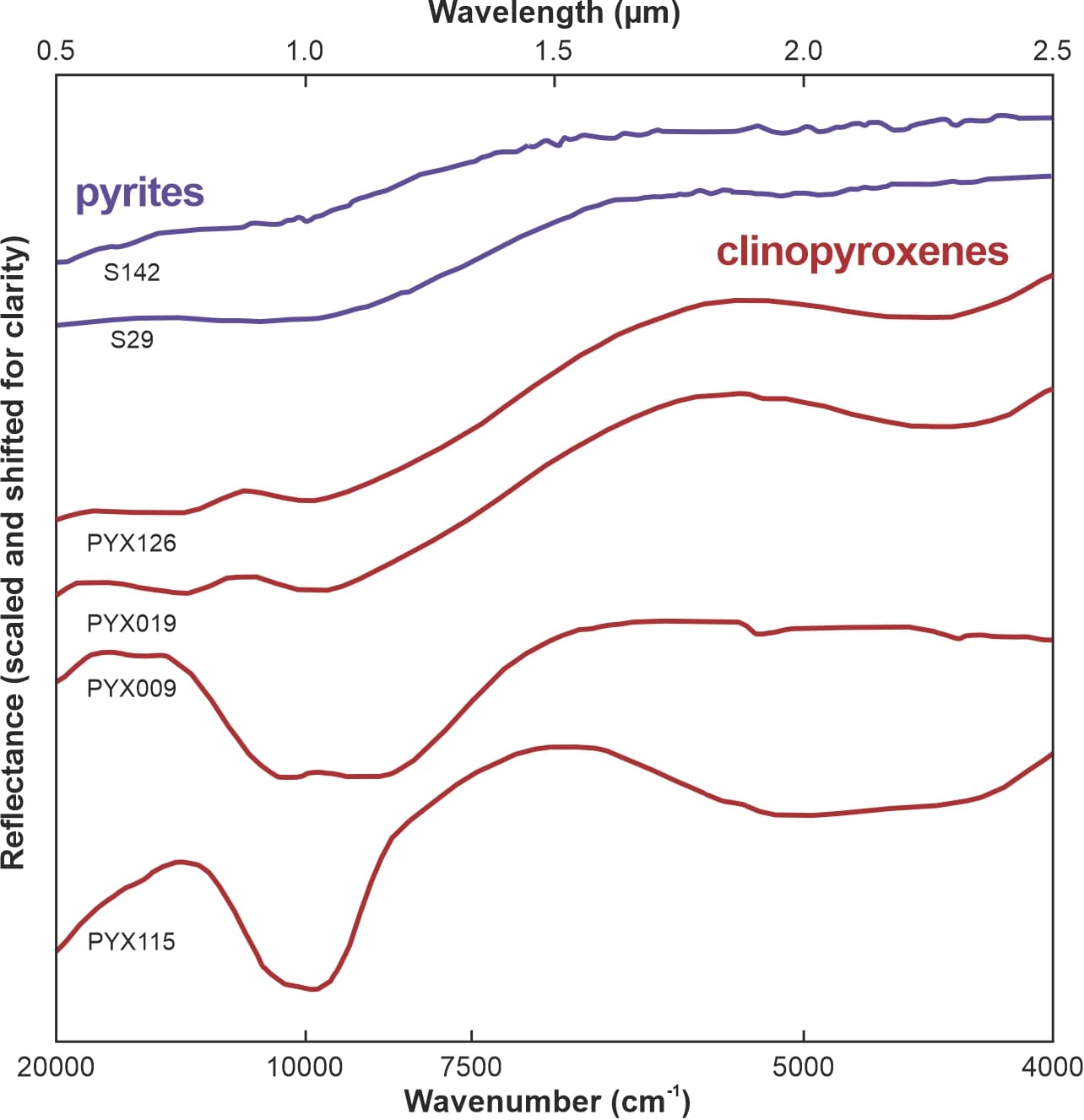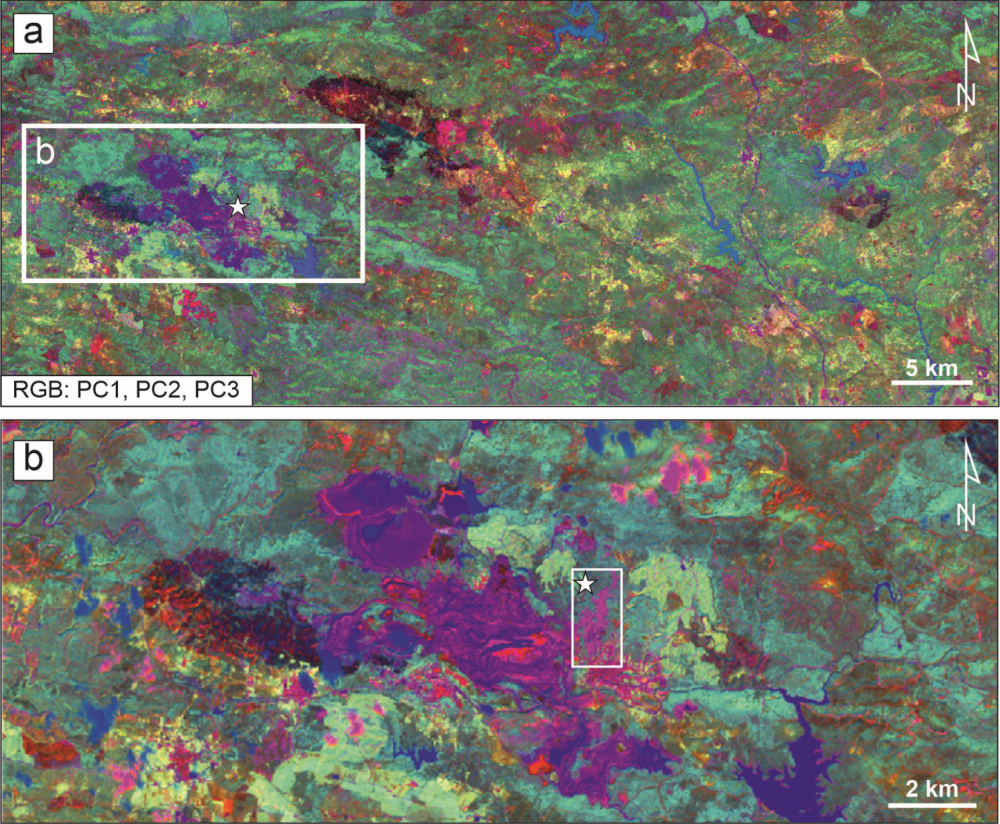- 1Institute of Geological Sciences, Polish Academy of Sciences, Wrocław, Poland (marrchia@gmail.com)
- 2Institute of Geology, Adam Mickiewicz University, Poznań, Polan
- 3Centro de Astrobiologia (CSIC-INTA), Planetary Geology and Habitability Department, Madrid, Spain
- 4IRSPS or International Research School of planetary Sciences
Data from martian rovers and martian meteorites indicate that ore minerals are common on Mars including sulfides such as pyrite, pyrrhotite, chalcopyrite and pentlandite. Three spectrometers: CRISM (The Compact Reconnaissance Imaging Spectrometer for Mars; spectral range 0.4−3.9 µm) onboard Mars Reconnaissance Orbiter (MRO), OMEGA (Observatoire pour la Mineralogie, l'Eau, les Glaces et l’Activité; spectral range 0.4 - 5.1 µm), and PFS (Planetary Fourier Spectrometer; spectral range 1.3-45.0 µm) onboard Mars Express (MEX) operate in near infrared (NIR) spectrum and provide information on the mineral composition of Mars. However, none of those is yet capable to efficiently identify sulfides. Detecting sulfide ore deposits is difficult in the NIR range due to spectral interferences with silicates (Fig. 1). Due to the limited in-situ measurements by the Opportunity, Spirit, Curiosity, and Perseverance rovers, Mars mineralogical studies must be supported by studies of terrestrial analogs. The most suitable analog for study of ore minerals is the Rio Tinto area in Andalusia, Spain, which hosts the largest known volcanogenic massive sulfide deposits on Earth (Martin-Izard et al., 2015). In this area, we analyzed satellite images available in the near infrared spectrum, and thus Sentinel-2, ASTER, and Landsat 8. Principle Component Analysis (PCA) of the obtained spectra from Sentinel-2 (Fig. 2), which has the best field resolution (10 m) of the three, gives similar results to mineralogical data we have retrieved in the field during our geological mapping in March 2022 (see Ciazela J. et al., this session).
By establishing our test field for remote sensing of sulfide deposits in a PFA site on Earth, we will be able to determine abundance thresholds for the detection of major sulfide phases on Mars and identify their key spectral features. Our results will help in 1) more efficient use of the current NIR Martian spectrometers to detect ore minerals and 2) designing new space instruments optimized for ore detection to include in future missions to Mars such as one developed at the Institute of Geological Sciences and the Space Research Centre of the Polish Academy of Sciences called MIRORES (Martian far-IR ORE Spectrometer).
Acknowledgments: The presented research are supported by Europlanet2024-research infrastructure grant no. 20-EPN2-020 and National Science Centre of Poland project OPUS19 no. 2020/37/B/ST10/01420 to J. Ciazela.
References:
Horgan, B.H.N., Cloutis, E.A., Mann, P., Bell, J.F., 2014. Near-infrared spectra of ferrous mineral mixtures and methods for their identification in planetary surface spectra. Icarus 234, 132–154.
Martin-Izard, A., Arias, D., Arias, M., Gumiel, P., Sanderson, D.J., Castañon, C., Lavandeira, A., Sanchez, J., 2015. A new 3D geological model and interpretation of structural evolution of the world-class Rio Tinto VMS deposit, Iberian Pyrite Belt (Spain). Ore Geol. Rev. 71, 457–476.

Figure 1. Near-infrared (NIR) spectra of pyrites S142 and S29 compared to those of clinopyroxenes PYX126, PYX019, PYX009, and PYX115, which are all described by Horgan et al. (2014). Note the lack of distinct spectral features in pyrites and their similarity to the NIR spectra of some clinopyroxenes. Considering the low pyrite abundances compared to those of clinopyroxene, pyrite is difficult to observe in the NIR range. The y-axis has no numerical scale as the plots are shifted for clarity.

Figure 2. False-color composite, Sentinel-2A PCA (10 m/px) for the study area: PC1, PC2, and PC3 in R, G, and B channels, respectively. PCA image was calculated from the original 9-band (VNIR + SWIR) of Sentinel-2A (bands 1, 9, and 10 were excluded from this analysis as they do not contain mineralogical/geological information). Three first PCA components (PCA1, PCA2, and PCA3), containing the highest topographical and spectral information, are suitable for lithological discrimination, especially for arid region such study area. The pink color indicates areas with high pyrite content. The white frame in panel 'a' marks the region of the Rio Tinto Mining area in Spain. The white frame with the star in panel 'b' shows our study area for geological mapping (see Ciazela J. et al., this session).
How to cite: Ciążela, M., Ciążela, J., Pieterek, B., Mancini, F., Marciniak, D., and Gomez, F.: Towards prospecting ore deposits on Mars: remote sensing of the planetary field analogue in the Rio Tinto mining area, Spain, Europlanet Science Congress 2022, Granada, Spain, 18–23 Sep 2022, EPSC2022-1090, https://doi.org/10.5194/epsc2022-1090, 2022.

